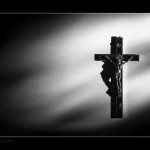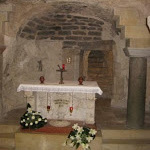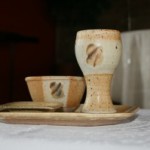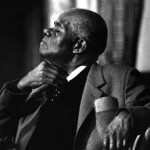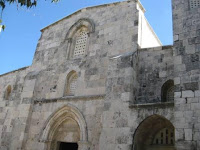 |
| Church of St Anne |
On our final day in Israel, nearly everyone chose to return to the Jerusalem Old City. At first many of use toured together visiting stations we missed along the Via Delarosa. St. Anne’s Church is the first Station of the Cross and is the only intact Crusader Church in the country. Saladin preserved this church to use as an Islamic school. It is there that we saw the ruins of what was the Pools of Bethesda.
 |
| Excavation of the Bethesda Pools |
Now there is in Jerusalem near the Sheep Gate a pool, which in Aramaic is called Bethesda and which is surrounded by five covered colonnades. Here a great number of disabled people used to lay — the blind, the lame, the paralyzed. One who was there had been an invalid for thirty-eight years. When Jesus saw him lying there and learned that he had been in this condition for a long time, he asked him, “Do you want to get well?” “Sir,” the invalid replied, “I have no one to help me into the pool when the water is stirred. While I am trying to get in, someone else goes down ahead of me.” Then Jesus said to him, “Get up! Pick up your mat and walk.” At once the man was cured; he picked up his mat and walked. (John 5:2-9). The Sheep Gate Pools were built upon what was previously a temple with pools dedicated to Asclepius, and that is likely where the superstition of the pools being able to heal came from. Asclepius was a human son of Apollo, who may or may not have been deified. He studied with the Centaur Chiron, from whom he learned the healing arts. Later he obtained, from Athena, blood from the right side of the Gorgon, which allowed him to raise the dead (Grimal, P. (1996). The Dictionary of Classical Mythology. Malden, MA: Wiley-Blackwell.). The Asclepius cult was active in many cities, as people sought healing. Whereas Asclepius was struck down by Zeus for upsetting the natural order in raising the dead, Paul pictures Christ as returning humanity to the life intended by God (1 Cor. 15:22).
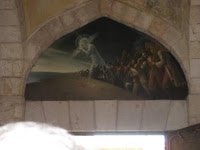 |
| The Saints carry their crosses |
 |
| Jesus falls under the cross and the angels weep |
We also visited the station where Jesus fell under the cross, and was assisted by Simon of Cyrene. As they led him away, they seized Simon from Cyrene, who was on his way in from the country, and put the cross on him and made him carry it behind Jesus. (Luke 23:26). The art here shows the angels weeping as Jesus bares the cross on one wall, and as we exit there is another painting showing all the saints in heaven also baring their crosses in joy as they follow Christ. Then Jesus said to his disciples, “If anyone would come after me, he must deny himself and take up his cross and follow me.” (Mt 16:24).
 |
| The “games” stones |
We also went to the station where Jesus would have been when Pilate judged him. “What shall I do, then, with Jesus who is called Christ?” Pilate asked. They all answered, “Crucify him!” “Why? What crime has he committed?” asked Pilate. But they shouted all the louder, “Crucify him!” When Pilate saw that he was getting nowhere, but that instead an uproar was starting, he took water and washed his hands in front of the crowd. “I am innocent of this man’s blood,” he said. “It is your responsibility!” All the people answered, “Let his blood be on us and on our children!” Then he released Barabbas to them. But he had Jesus flogged, and handed him over to be crucified. (Matt. 27:22-26). Although it is difficult to see in the photograph, there are games carved into the stones on the ground. It is thought that those are game boards that the Roman soldiers would have used. Walking the Via Delarosa allows one to see how close all these government buildings were in Jesus’ day, and how they were able to railroad him in one night. Instead of think thinking that they were running Jesus all over the city, it is better to think of it as they were moving him between various offices at city hall. That is why they were able to get a death sentence in about the same time it takes us to get a building permit.
After this, groups split up to going shopping through the Old City. I think only the items being sold have changed since Jesus’ time. Merchants and beggars line the streets shouting and bartering. Bruce, Shawn, and I had quite a good time learning to negotiate with the locals.
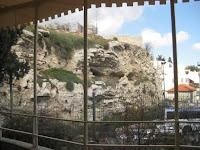 |
| Hill of the Skull |
 |
| Doorway to the tomb |
 |
| Typical stone to cap a tomb |
The final place we visited before leaving Israel was the Garden Tomb. This is another possible site for the crucifixion and burial of Jesus. From my perspective the evidence was convincing for this site. The keepers of this site do not claim that this is the definitive site, but do say that it fits the biblical evidence. It is outside a Roman gate, the Damascus Gate. It is along a busy road, which fits where Romans crucified criminals. The hill has the look of a skull. The tomb is in a garden (vineyard). The tomb is a rich man’s tomb, which had never been used because it was not completely finished. The doorway would require a larger that normal rolling stone to close the entrance. The floor plan of the tomb is unique, with the bodies to be placed on the right of the tomb as on enters, instead of toward the back. I was asked to lead the service of the Lord’s Table here, and I was assisted by pastors Shawn, Tim, and JK.
 |
| The grape press |
 |
| Inside the tomb |
Being able to perform both the sacraments of baptism in the Jordan and the table in the Garden Tomb were two events that will be in my memory ministry memorial pillars.













